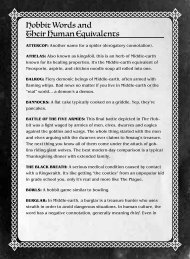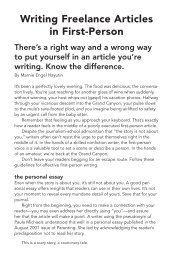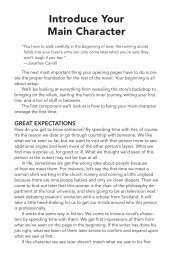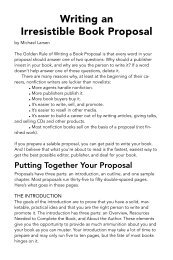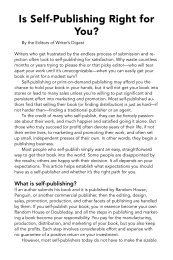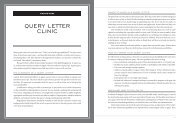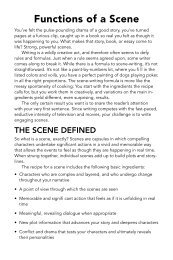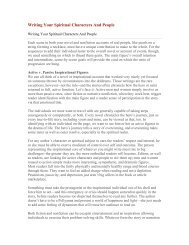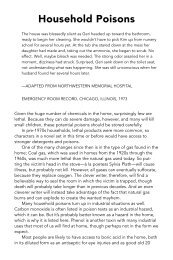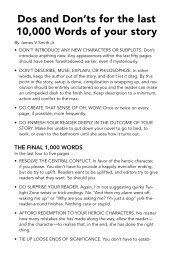The 5 Revision Methods: Which One is for You? - Writer's Digest
The 5 Revision Methods: Which One is for You? - Writer's Digest
The 5 Revision Methods: Which One is for You? - Writer's Digest
You also want an ePaper? Increase the reach of your titles
YUMPU automatically turns print PDFs into web optimized ePapers that Google loves.
<strong>The</strong> 5 <strong>Rev<strong>is</strong>ion</strong> <strong>Methods</strong>:<br />
<strong>Which</strong> <strong>One</strong> <strong>is</strong> <strong>for</strong> <strong>You</strong>?<br />
Rev<strong>is</strong>ing <strong>is</strong> a critical part of any creative process. Follow<br />
these tips to find the method that works best <strong>for</strong><br />
you and your story.<br />
<strong>The</strong>re are two kinds of writers: those who prefer rewriting to creating the<br />
original draft, and those who face it with all the enthusiasm of a surgeon<br />
<strong>for</strong>ced to operate on himself. No matter which side of the fence you’re<br />
on, there’s no escaping the larger point: Rewriting <strong>is</strong> absolutely necessary<br />
<strong>for</strong> your fiction to reach its full potential.<br />
Very few stories are aced on the first shot. Leo Tolstoy rewrote Anna<br />
Karenina 17 times. Jean Auel calls the rev<strong>is</strong>ion stage “where I get a handle<br />
on the book.” And Isaac Bashev<strong>is</strong> Singer considered the wastebasket<br />
the “writer’s best friend.”<br />
But when should you rewrite? And how much? As with so much in<br />
fiction writing, rev<strong>is</strong>ion methods aren’t one-size-fits-all. Here are five possibilities—one<br />
will be right <strong>for</strong> you.<br />
1. Write the entire first draft without stopping and rewrite only after<br />
it’s done. Th<strong>is</strong> approach <strong>is</strong> especially good <strong>for</strong> writers who, instead of<br />
working from an outline, just plunge in and see where the story goes. If<br />
you do th<strong>is</strong>, concentrate on characters and plot, and ignore all incons<strong>is</strong>tencies<br />
and wrong turns (there will be plenty). Just block them out of<br />
your mind and move <strong>for</strong>ward. If you can’t do that—if you’re too bothered<br />
by the scene in Chapter 3 that makes no sense when the story<br />
reaches Chapter 8—then th<strong>is</strong> method <strong>is</strong>n’t <strong>for</strong> you.<br />
2. Write until the story “comes together,” then stop and rewrite<br />
until th<strong>is</strong> point. Th<strong>is</strong> works <strong>for</strong> many of my students. <strong>The</strong>y begin writing<br />
characters into a dramatic situation, but they do it without knowing<br />
just how everything will end up or what it will all mean. Halfway<br />
through the first draft (or two-thirds or three-quarters), they reach an<br />
“Aha!” moment in which everything adds up. At th<strong>is</strong> point, they make<br />
hasty notes, stop and go back to the beginning, rewriting until all the<br />
previous scenes lead up to the climax. <strong>The</strong>n they write the climax.<strong>One</strong><br />
note: If you’re three-quarters of the way through a first draft, and you<br />
still haven’t found an “Aha!” moment, your entire story <strong>is</strong> probably
dead. Th<strong>is</strong> happens. Organic writing <strong>is</strong> always r<strong>is</strong>kier than preplanned<br />
work, but <strong>for</strong> some writers, it’s also more exciting.<br />
3. Rewrite at the end of each scene. <strong>The</strong> scene <strong>is</strong> the basic unit of<br />
fiction (more on th<strong>is</strong> later). Some writers like to stop after each one<br />
and rev<strong>is</strong>e it to be the best it can be. Th<strong>is</strong> builds a firm foundation <strong>for</strong><br />
the next scene.<br />
4. Rev<strong>is</strong>e at the end of each chapter. For novel<strong>is</strong>ts, th<strong>is</strong> <strong>is</strong> an extended<br />
version of the scene approach.<br />
5. Rev<strong>is</strong>e as you go along, sentence by sentence. Th<strong>is</strong> works best<br />
if you know the entire shape of your story be<strong>for</strong>e you begin. <strong>You</strong> can<br />
thus divert attention from such questions as, “What on earth should<br />
happen next?” and place it on crafting the best possible sentence<br />
now. Writers who take th<strong>is</strong> approach, including Tom Robbins and<br />
Michael Swanwick, tend to write very slowly—but it works <strong>for</strong> them.<br />
Other writers, though, find th<strong>is</strong> constant rechewing of paragraphs<br />
unbearable.<br />
<strong>The</strong> four keys<br />
No matter what method you use, rewriting involves four key concepts.<br />
How much rev<strong>is</strong>ion your manuscript needs depends both on how much<br />
rev<strong>is</strong>ing you did as you wrote and how well you’ve already con<strong>for</strong>med to<br />
the following critical areas.<br />
1. Story arc<br />
Scrutinize the beginning of your story. What are the characters like, especially<br />
the protagon<strong>is</strong>t? <strong>Which</strong> character knows what, and about whom?<br />
What situation provides the conflict? <strong>You</strong> may find it helpful to make brief<br />
notes on these points.<br />
Next, do the same <strong>for</strong> the end of the story. Here’s the important<br />
question: What in your story <strong>is</strong> significantly different? <strong>You</strong> should be able<br />
to identify changes in your characters and their situations. Th<strong>is</strong> <strong>is</strong> your<br />
story arc. Is it strong enough, and interesting enough, to justify your<br />
readers’ ef<strong>for</strong>t? Does it reveal what you want it to reveal?<br />
If your story arc falls short, then that’s where you should begin your<br />
rewrite. How would the ending have to be different to create a stronger<br />
arc? How do you need to change the beginning? What clear-cut difference<br />
between the two do you want to create? Write it down.<br />
2. Scene changes
<strong>The</strong> scene <strong>is</strong> the basic unit of fiction, in that each <strong>is</strong> a miniplay with its<br />
own beginning, middle and end. Look at each scene, one by one (even<br />
in a 500-page novel), and decide:<br />
• Do you need th<strong>is</strong> scene? Does it contribute to your story arc? Delete<br />
any that don’t (yes, even if you love them). Look especially at the first<br />
few scenes—many stories can be vastly improved by starting later in<br />
the action, since “set-up” scenes tend to be more static.<br />
• Are you m<strong>is</strong>sing any scenes that are necessary <strong>for</strong> your character arc? If<br />
so, decide where to put them and write them.<br />
• Does every scene sufficiently orient the reader in time and space?<br />
Readers always need to know where they are, how much time has<br />
elapsed since the previous scene and who’s present.<br />
• Can you turn any large chunks of exposition into a dramatized scene?<br />
Should you? (If you’re writing commercial fiction, the answer <strong>is</strong> probably<br />
yes.)<br />
• Does every scene move the plot <strong>for</strong>ward and reveal character? If any<br />
don’t, rewrite them to give your characters actions that do both.<br />
• s every scene vivid? Can you make them come to life through sharper<br />
dialogue or more description? Remember to include sensory details of<br />
smell, sound and texture.<br />
• Does every scene come to some sort of interesting end—a r<strong>is</strong>e in<br />
emotion, a new story element introduced, a heightening of conflict,<br />
a new insight <strong>for</strong> the reader? Is there something to make your reader<br />
want to go on to the next scene? If not, the scene needs rewriting.<br />
Whether you did all th<strong>is</strong> as you wrote or did it after a complete first draft,<br />
you’ve now got your story arc and scenes under control. Congratulations!<br />
<strong>The</strong> hardest part of rewriting <strong>is</strong> done.<br />
3. Sentences and paragraphs<br />
Now go through the entire manuscript again, looking at individual types<br />
of sentences and paragraphs. <strong>The</strong> questions here are:<br />
• Is your dialogue natural and in keeping with each character’s personality?<br />
Correct any slips in diction, out-of-character statements or dialogue<br />
that fills the reader in on plot but <strong>is</strong>n’t something the character would<br />
actually say.
• Are your descriptions vivid and detailed? Do they hang together to<br />
create an accurate, dominant impression? Are they as conc<strong>is</strong>e as you<br />
can manage? (Remember that some readers skip long, descriptive<br />
passages.) Would it help to break up your descriptive passages and<br />
scatter the pieces among dialogue and action?<br />
• Is your narrative smooth? Fix any sentences that read awkwardly.<br />
Clarify ambiguities. (For example, in the sentence “Mattie helped Jane<br />
put on her muffler,” whose muffler <strong>is</strong> Jane wearing?) Double-check any<br />
factual details. (Is a regulation basketball hoop really 9 feet from the<br />
floor? Or <strong>is</strong> it 10?) Cut unnecessary repetition.<br />
4. Cleanup<br />
By now you may be sick of your story. But proofread it one more time <strong>for</strong><br />
spelling (your computer’s spell-checker can’t pick up the difference between<br />
its and it’s), grammar, and printing errors such as smudged letters<br />
and <strong>for</strong>mat problems.<br />
Th<strong>is</strong> <strong>is</strong> especially important in the opening pages. <strong>You</strong> don’t want an<br />
editor turned off by failures of subject-verb agreement be<strong>for</strong>e he even<br />
gets to the exciting stuff.<br />
And then you’re done—at least until an editor buys your work and<br />
asks <strong>for</strong> further rev<strong>is</strong>ions. But that’s another story.<br />
Nancy Kress’s most recent novel <strong>is</strong> Crucible (Tor/St. Martin’s Press).



